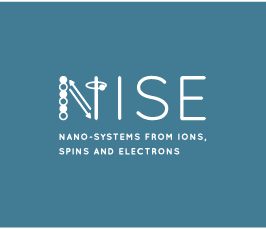Spin-orbit torque switching in antiferromagnets
Seminar
- Datum: 11.10.2019
- Uhrzeit: 11:00
- Vortragende(r): Dr. Cheng Song
- Tsinghua University, Shool of Materials Science and Engineering
- Ort: Max-Planck-Institut für Mikrostrukturphysik, Weinberg 2, 06120 Halle (Saale)
- Raum: Lecture Hall, B.1.11

Antiferromagnets with zero net magnetic moment, strong anti-interference and ultrafast switching speed have potential competitiveness in high-density data storage. Electrical switching of antiferromagnets is at the heart of their device application [1,2]. The antidamping torque-induced switching of Néel order is attained in a biaxial antiferromagnetic insulator NiO, which is manifested electrically via spin Hall magnetoresistance in NiO (100)/Pt bilayers [3]. The antiferromagnetic moments are switched towards the current direction, different from the vertical configuration in the fieldlike torque scenario [4,5]. Electric field is used to switch the magnetic moment of Mn2Au films grown on piezoelectric Pb(Mg1/3Nb2/3)0.7Ti0.3O3 (PMN-PT) (011) substrates. When the electric field is swept, the easy axis of Mn2Au is switched between [100] and [0 1] directions of PMN-PT (011) at room temperature, exhibiting a butterfly-like swithing feature. This feature indicates that the underlying mechanism is the electric field-induced ferroelastic strain. Such a transition of the easy axis leads to the change of threshold current for the field-like torque switching of Mn2Au [6]. An atypical spin-charge conversion and spin-orbit torques in Mn2Au/permalloy bilayers will be also discussed. Spin current whose polarization (δz) and flow directions are parallel or antiparallel to the film normal is allowed when a charge current is passing through Mn2Au film, and produce an in-plane field torque on the adjacent permalloy [7]. Electrical switching of antiferromagnetic moments pave the way for all-electrical writing and readout in antiferromagnetic spintronics.
[1] C. Song, et al. Nanotechnology 29, 112001 (2018)
[2] C. Song, et al. Prog. Mater. Sci. 87, 33 (2017)
[3] X. Z. Chen, et al. Phys. Rev. Lett. 120, 207204 (2018)
[4] X. F. Zhou, et al. Phys. Rev. Appl. 9, 054028 (2018)
[5] X. F. Zhou, et al. Phys. Rev. Appl. 11, 054030 (2019)
[6] X. Z. Chen, et al. Nat. Mater. 18, 931 (2019)
[7] W. W. Kong, et al. submitted.
Bio: Dr. Cheng SONG is tenured associate professor of Tsinghua University. Prior to joining Tsinghua University, he was Humboldt Research Fellow at University of Regensburg (2009-2011). He has published more than 160 peer-reviewed papers on functional antiferromagnets, electrical control of ferromagnetism, spin-orbit torque, spin injection, and oxide interface, including papers in Nature Mater., Nature Commun., Phys. Rev. Lett., Adv. Mater, and Prog. Mater. Sci. Sum of times cited of these papers are >4800 according to Web of Science, H-index=37. Award/Honors: Young Yangtze river scholars, National Science Fund for Excellent Young Scholars.